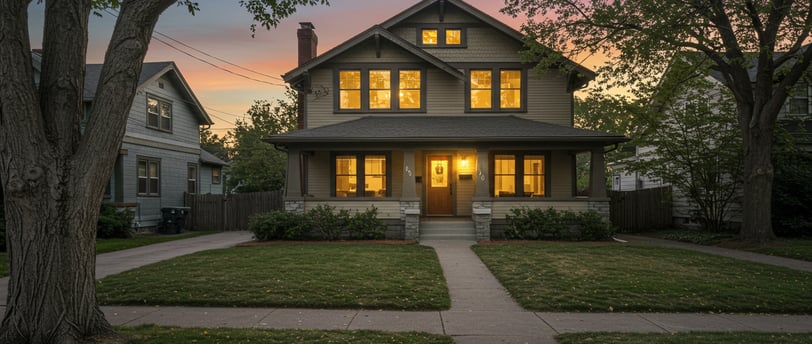Is That Old House a Diamond or a Dud?
How to spot costly problems before you buy an older home
OLDER HOMESDIYCOST ANALYSIS
1/30/20254 min temps de lecture


Older homes have a certain charm, often featuring unique architectural details and solid construction that modern homes sometimes lack. However, they can also come with hidden problems that turn your dream home into a financial nightmare. Before you get swept up in the beauty of a vintage property, it's essential to inspect key areas for costly issues. Here are some potential red flags and how to avoid common mistakes.
The Roof: Your First Line of Defense
The roof is one of the most critical components of a house. A compromised roof can lead to leaks, structural damage, and expensive repairs. Here are some things to look for:
Inspect the roofline: A straight and even roofline is ideal. If the roof appears to sag or bow, this could indicate structural problems that may require a costly fix.
Examine the shingles: Older three-tab shingles are less durable than modern architectural shingles. If the shingles appear worn, curled, or missing, the roof might need replacement.
Look for damage: Visible sheathing, dark spots, or bare patches are warning signs that the roof is deteriorating.
Consider replacement costs: A new roof can cost anywhere from $25,000 to $30,000, so factor this into your budget.
Water Management: Keep Moisture Out
Water damage is one of the most expensive and difficult issues to fix in an older home. Ensuring proper water drainage is crucial to preventing mold, foundation problems, and rot.
Check the ground slope: The yard should slope away from the foundation to prevent water from pooling. A poor slope can lead to water infiltration in the basement.
Inspect for organic materials near the home: Having soil, plants, or mulch directly against the house can trap moisture, leading to foundation rot and pest issues. Removing trees and gardens near the foundation may cost a few thousand dollars.
Consider installing a French drain: If water is pooling around the home, a French drain system—which includes a trench, membrane, and weeping tile—can be a worthwhile investment. A DIY installation costs around $1,000 in materials.
Examine temporary structures: Decks, fences, and sheds should be checked for rot. If you can push a screwdriver into the wood, it may need replacement. A new deck can cost around $5,000, while a basic shed may run $3,500.
Assess rainwater flow: Ensure that rainwater is directed away from the house. Clogged or missing gutters can lead to water damage.
Inspect windows and siding: Cracked siding, unsealed gaps, or deteriorating window frames can allow moisture to enter, leading to costly repairs. Replacing all windows in a four-bedroom home can cost between $25,000 and $30,000.
Electrical System: Is It Up to Code?
Electrical issues are common in older homes, and upgrading the system can be expensive. Before purchasing, check the following:
Service amperage: Many older homes have 100-amp service, which may not support modern appliances and upgrades like hot tubs. Some areas require 200-amp service.
Upgrade costs: Upgrading to 200-amp service can cost between $10,000 and $20,000. However, some local power authorities offer financial assistance for upgrades.
Old wiring concerns: Homes with aluminum wiring can be problematic, as connections may loosen over time, creating fire hazards.
Foundation: The Base of Your Home’s Stability
A compromised foundation can lead to serious structural issues. When inspecting the foundation, look for:
Cracks and settling: Minor cracks may be normal, but large or widening cracks, especially in mortar joints, could signal structural movement.
Bowing walls: If basement walls appear to be bowing inward, this could indicate serious foundation problems requiring professional repair.
Signs of moisture: Vertical cracks in cinder blocks may suggest water damage, especially if there are organic materials (like soil) against the foundation.
Insulation gaps: Proper insulation in the rim joist can help prevent ice dams and mold from forming in the home.
Mechanical Systems: The Heart of the Home
A home’s mechanical systems—furnace, water heater, and plumbing—play a critical role in comfort and efficiency.
Furnace room inspection: Ensure the furnace is properly installed and insulated. If the furnace is placed on a concrete floor without elevation, it may be susceptible to water damage.
Equipment age and efficiency: Check for stickers on the furnace, water heater, and air conditioning unit to determine their age. Older equipment may need replacement soon.
Proper ventilation: Make sure there’s a cold air return in the basement to allow for proper air circulation.
Plumbing updates: Copper water lines should be at least ¾ inch in diameter. If you see outdated galvanized pipes, they may need replacement to prevent rust and low water pressure.
Interior Considerations: What’s Inside Matters Too
The inside of an older home can also present challenges. Pay close attention to these details:
Insulation quality: Use a thermal camera to detect cold spots that indicate missing or inadequate insulation.
Home layout: Older homes tend to have smaller rooms and numerous closets, which may not fit modern preferences.
Load-bearing walls: If you plan to renovate, check the attic for trusses. If present, the interior walls may be non-load-bearing and easier to remove.
Settling issues: If doors stick or do not close properly, it could indicate the house is settling unevenly.
Asbestos and lead paint: Homes built before 1978 may contain lead-based paint or asbestos in walls, ceilings, and insulation. Professional testing is advised.
Other Potential Issues to Watch For
Beyond the major systems, here are a few additional concerns:
Lack of exhaust fans: Many older homes do not have proper kitchen and bathroom exhaust fans, leading to moisture buildup.
Subfloor moisture: Subfloors in basements can trap moisture, promoting mildew and mold growth.
Pest problems: Poor insulation and foundation cracks can allow pests to enter the home.
Final Thoughts: Is It Worth It?
Buying an older home can be a rewarding investment, offering unique charm and character. However, it’s essential to understand the potential challenges and hidden costs before making a decision. Conduct a thorough inspection, get professional advice when needed, and budget accordingly for necessary repairs and upgrades. With careful planning, you can turn an aging house into the home of your dreams while avoiding unexpected financial setbacks.
Quantum Scope Inspections
La Santé de Votre Maison, Notre Priorité Absolue
Obtenez le Manuel du vendeur de maison, édition 2025
Maximisez votre investissement avec des réparations et de l'entretien, sur Amazon
© QuantumScope Inspections 2025 | Tous droits réservés | Politique de Confidentialité
Conception du site web par Creative Web Design Lab
